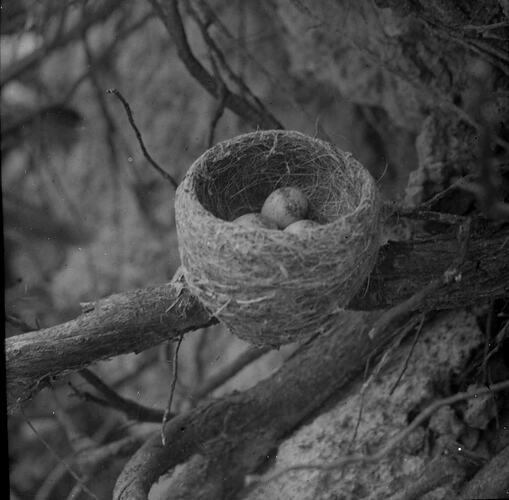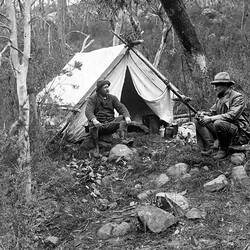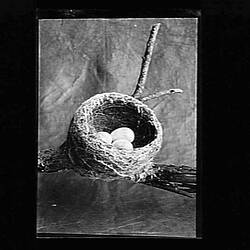BLACK AND WHITE FANTAIL (Rhipidura Tricolor, Veillot - 139 and 140)
Geographical Distribution - Australia in general, also New Guinea, Aru Islands, Solomon Islands and New Ireland.
Nest - Cup-shaped, neat and symmetrical, with narrow but well-built sides, composed of dried grass or fine shreds of bark, felted outwardly with spiders' webs, some of the webs being worked round and underneath the fork or branch on which the nest is placed; lined inside with finer grass, a few fibrous rootlets, feathers, hair, &c., and usually situated on the dead portion of a low horizontal branch a few feet from the ground, more frequently above water. Dimensions over all, 2 ¾ inches by 1 ¾ inches in depth; egg cavity, 2 ½ inches across by 1 ½ inches deep. (See illustration.)
Eggs - Clutch, three to four; inclined to be oval in shape, prominently rounded at one end; textured fine; surface slightly glossy; colour, light creamy-buff or yellowish-white, marked and spotted, usually faintly but sometimes boldly, with light-rufous or olive and grey, generally in the form of a belt around the upper quarter. Dimensions in inches of a full clutch: (1) .8 x .57, (2) .79 x .59, (3) .79 x .58, (4) .78 x .6; of a larger-sized pair: (1) .87 x .6, (2) .8 x .6. (Plate 8)
Observations - This bird is a simple study in black and white - the general plumage being glossy black relieved with a narrow line over either eye and abdominal parts white. Eyes, bill, and feet are black. Total length 7 ¾ inches, including tail 4 ½ inches and bill ¾ inch.
If we include the smaller race of the north-west part of the Continent,? then the common Black-and-white Fantail is found throughout the whole of the Australia.
One hardly knows where to commence the observations, which are always interesting, of this general favourite, sometimes called 'Wagtail' or 'Shepherd's Companion.' I shall just lead off from Mr. Lau's manuscript. Writing with reference to the Darling Downs, he says: - 'Queensland seems more the home than New South Wales of this lively, intrepid little customer, because, in spite of untiring search in the southern part of the last named State, I was never rewarded with its nest, although I often met with the bird. A lover of water, it courts the friendship of the Magpie Lark (Grallina), often builds with it in the same tree, chases with the Magpie Lark intruders, and finds with it the sustenance of life on the margin of a rivulet. The Fantail dances on the backs of horses, cattle or sheep, in search of parasites, also hopping in the grass before the devouring mouths of such animals, watching for frightened insects ascending from their hiding places. When with the Magpie Lark, the situation of the nest is high; but it builds low enough, frequently over water on the top of so-called snags, on posts, &c. Once in Glenelg I knew of a nest on the stem of a vine before my bed-chamber. In passing by, the birds always greeted me, but one morning the eggs were gone. I swore revenge and laid poison in the nest, which the following morning contained the corpse of a fat lizard. The open nest is neatly formed out of decayed grass and spiders' webs, lined with fibres, and contains three or four eggs. At least three broods are reared in a season, which extends from the end of August or September to December.'
I have taken these homely little birds' nests in Victoria, New South Wales and Queensland, and never particularly noticed, as Gould states, that a living branch always overshadowed the dead branch bearing the nest. Nor have I noticed any particular predilection of the Fantail to nest near a Magpie Lark's home. On one occasion I recollect finding a Fantail's nest with eggs in a small tree growing in a lagoon, near a Grallina's containing young, but there was also in the same tree a nest of the White-rumped Wood Swallow, with a set of beautiful eggs, placed within an old nest of a Grallina.
With their peculiar rattle-like noise and restless actions, the Fantails soon betray the whereabouts of their nests.
In confirmation of Gould and Mr. Lau's other remarks, that the Black-and-white Fantail sometimes rears three broods in a season, a farmer friend took particular notice of a pair near his home, and proved the fact, with the additional original informed that the first two broods, in that instance, were reared from the same nest.
A correspondent of the 'Queenslander', who enjoyed opportunities of watching the Black-and-white Fantail building its nest, states: - 'The site chosen for the nest is the horizontal fork of a small dead branch, generally near the tope of a tall tree standing close to water. Occasionally they build in a similar position in a fallen tree, and once I saw nest on the flat beam of a boat-house - a most unusual place. Having decided on a site, they call upon the patient and hard-working spiders, whose carefully-woven nets are torn away. The foundation is made by twisting the cob-webs around, under and across the two sides of the fork. Next a great many trips are made to the banks of the creek. Here they obtain the thread-like roots of plants, which have been exposed by the water washing away the soil. These rootlets, together with strips of soft bark, are twisted round the fork until a cup-like shaped is formed, the bird helping to mould it by turning round and round within the little cup and pushing and working it with its little breast, until the neatest and most perfect cup imaginable is at last formed. Then another visit is paid to the spiders, and with some more of their webs the birds cover the outside. The webs bind the roots together, and also give the net the exact appearance of the dead branch upon which it is placed, so that it quite resembles one of the warts or excrescences so common on our trees. No lining is needed, for the inside is quite soft'.
The Black-and-white Fantail is exceedingly persevering in nest-building. The same correspondent one season notices no less than four nests build and eggs laid therein, which were either destroyed or stolen before the birds reared a brood. In one instance they removed portions of a previous nest to construct a fresh one some distance off.
The history of a home: - 'A pair of 'Shepherds' built their nest in the peach-tree near my window. They started 28th August, had one egg on the 9th September, three by the 11th, and all hatched after dinner on the 26th.' - (E.D.B.)
In the Dandenong district, Victoria, Messrs. Brittlebank and other collectors have on several occasions taken the egg of the Pallid Cuckoo (C. pallidus) from the nest of the Black-and-white Fantail. In the Adelaide Museum there is a curious exhibit, a Black-and-white Fantail's nest built on the loop of a rope.
The breeding months are from September to December, and probably in some localities to January.
Resources
Transcribed from Archibald James Campbell. Nests and Eggs of Australian Birds, including the Geographical Distribution of the Species and Popular Observations Thereon, Pawson & Brailsford, Sheffield, England, 1900. Transcribed from pp. 116-118.
More Information
-
Keywords
-
Authors
-
Contributors
-
Article types


